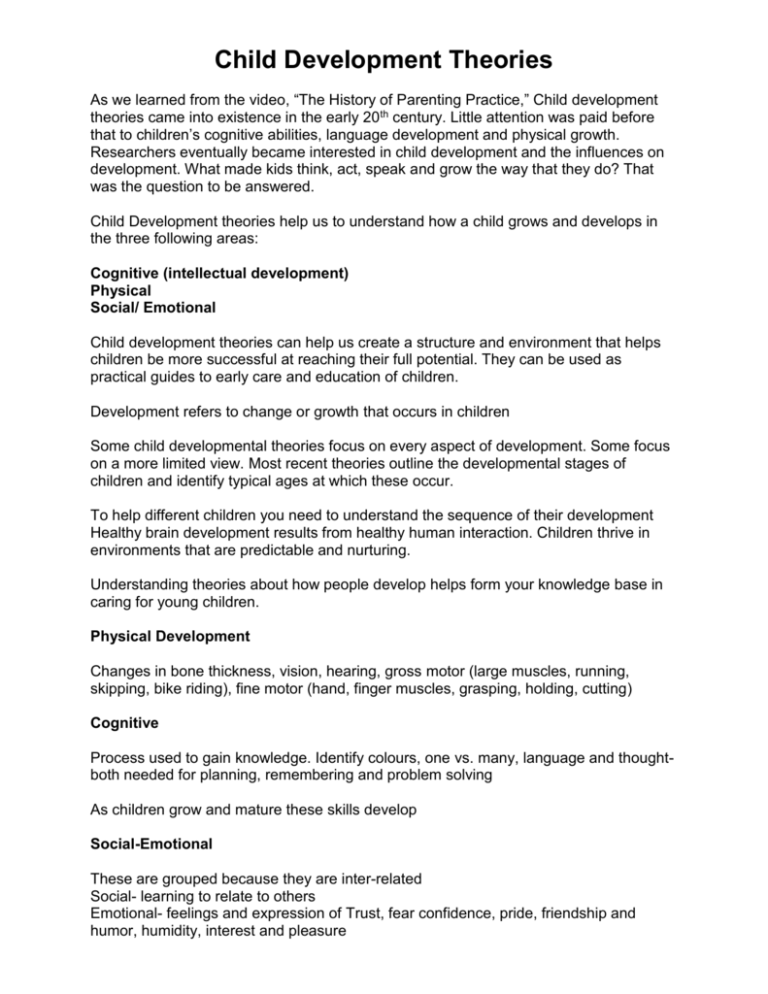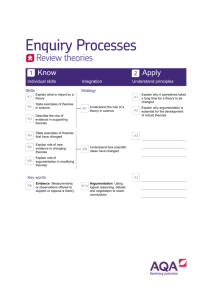Child Development Theories note
advertisement

Child Development Theories As we learned from the video, “The History of Parenting Practice,” Child development theories came into existence in the early 20th century. Little attention was paid before that to children’s cognitive abilities, language development and physical growth. Researchers eventually became interested in child development and the influences on development. What made kids think, act, speak and grow the way that they do? That was the question to be answered. Child Development theories help us to understand how a child grows and develops in the three following areas: Cognitive (intellectual development) Physical Social/ Emotional Child development theories can help us create a structure and environment that helps children be more successful at reaching their full potential. They can be used as practical guides to early care and education of children. Development refers to change or growth that occurs in children Some child developmental theories focus on every aspect of development. Some focus on a more limited view. Most recent theories outline the developmental stages of children and identify typical ages at which these occur. To help different children you need to understand the sequence of their development Healthy brain development results from healthy human interaction. Children thrive in environments that are predictable and nurturing. Understanding theories about how people develop helps form your knowledge base in caring for young children. Physical Development Changes in bone thickness, vision, hearing, gross motor (large muscles, running, skipping, bike riding), fine motor (hand, finger muscles, grasping, holding, cutting) Cognitive Process used to gain knowledge. Identify colours, one vs. many, language and thoughtboth needed for planning, remembering and problem solving As children grow and mature these skills develop Social-Emotional These are grouped because they are inter-related Social- learning to relate to others Emotional- feelings and expression of Trust, fear confidence, pride, friendship and humor, humidity, interest and pleasure Learning to express emotions in appropriate ways starts early in life. Self-concept, selfesteem are linked to social/emotional development. Different Types of Child Development theories and an example of the Theorist Psychoanalytical Theorists: Sigmund Freud and Erik Erikson Cognitive Child Development Theories: Jean Piaget Behavioural Child Development Theorist: John B. Watson, Ivan Pavlov, B.F. Skinner Social Development Theories: John Bowlby, Albert Bandura, Lev Vygotsky Ages/Stages Birth-1 year-Infant 1 year-3 year old-Toddlers 3 years-6 years old-Pre-schooler 2 year olds like to run and should be provided with lots of open space. Infants explore with their mouths so all toys should be kept clean and safe. Development Follows key patterns or principals, these might influence how you care for children Principals of Development Cephalous caudalprincipal; head --> down Proximodistal principal; center of body outwards Maturation; sequence of biological changes A child must mature to a certain point before they gain some skills. E.g. 4 months they can’t talk Brain Development Most rapid growth 1st 3 years of life, therefore it heads into infancy, may have more information development than mouths in middle age. Child development, principals and theories A theory is a principal or idea that is proposed, researched and generally accepted as explanation, Dev. theories provide insights into how children grow and learn. Theories can be used to help make decisions. Theories are based on observations and experiences with children Although each theory looks at development from a different angle, each offers a wealth of insight into how children develop. All theorists agree, children learn but in a caring environment rich in learning. **Drama Activity** Erik Erikson’s theory, Page 77 explanation







